The “Back to top” button can be found at the end of each phase description.
The path request process in PCS consists of the following phases:
- Phase Open
- Phase Harmonization
- Phase Path Request
- Phase Pre-booking
- Phase Path Elaboration
- Phase Draft Timetable
- Phase Observations or Acceptance
- Phase Post-processing
- Phase Final Offer
- Phase Active timetable
- 10.1 Phases of Path Modification
- 10. 2 Phases of Path Alteration:
- Phase Closed
- Phases of Pre-Arranged Paths:
1. Phase Open (O)

DESCRIPTION
- The first phase for the following processes
- New Path Request
- Late Path Request
- Ad-hoc Path Request
- Any Applicant can start the creation of a completely new dossier or copy and create a new dossier from an existing one.
- By default, the Applicant that creates the dossier becomes the leading Applicant of the new or copied dossier.
- If the Applicant changes the leading Applicant, the dossier only becomes available to the new Applicant’s leading company
POSSIBLE TRANSITIONS

Transition list
- Open -> Harmonization
- Who: Leading Applicant
- Restrictions
- Required fields: Dossier name, reference point and its time, Leading IM
- Open -> Closed
- Who: Leading Applicant
- Restrictions: None
PERMISSIONS
- Leading Applicant
- Read everything
- Write everything
- Applicants
- None
- Leading IM
- None
- IMs
- None
OTHER DETAILS
- If the Applicant creates the dossier in the wizard, in the Create New Dossier Wizard (CNDW) a draft version can be saved at any time before the new dossier is created.
- The system automatically sets the Applicant-IM pairs.
- When the Applicant enters the operation points, the system automatically recognizes the Infrastructure Manager (IM) involved for the particular point and adds him automatically as a participant IM to the dossier.
- Changing the participating companies is possible for the Leading Applicant at the Phases Open, Harmonization, and Harmonization Conference.
- There is no limitation on the number of companies that can participate.
- A participating company does not have to have operation points included in the timetable.
- Other companies can also be involved in the approval process or they can have only read access, like service companies or companies with through carriages or connections to the Dossier.
- It is not mandatory for more than one Applicant or Infrastructure manager to participate in a dossier. For example, the pre-arranged paths do not contain Applicant-IM pairs as in the regular dossiers.
2. Phase Harmonization (H)

DESCRIPTION
- Once the dossier is released to the Harmonization phase the dossier is visible to all involved applicants
- The harmonization phase allows all the participating Applicants in the dossier to begin to work in their respective sections
- The Applicants should use this phase to prepare a consistent dossier for placing their path request or for consultation with IMs via the Harmonization Conference
POSSIBLE TRANSITIONS

Transition list
- Harmonization -> Closed
- Who: Leading Applicant
- Restrictions: None
- Harmonization -> Harmonization Conference
- Who: Leading Applicant
- Restrictions
- Dossier with PaPs: Only possible if the dossier contains at least one Feeder or an Outflow
- Dossier without PaPs: No restrictions
- Harmonization -> Pre-Booking
- Who:
- Leading Applicant
- Restrictions
- This transition applies always to dossiers with at least one PaP section
- Complete all missing data
- All Applicant lights must be green
- Restrictions
- PCS system (Automatic promotion)
- The dossier must contain at least one PaP section
- Complete all missing data
- All Applicant lights must be green
- Leading Applicant
- Who:
- Harmonization -> Path Request
- Who:
- Leading Applicant
- Restrictions
- The dossier doesn’t contain PaPs
- Complete all missing data
- All Applicant lights must be green
- Restrictions
- PCS system (Automatic promotion)
- Restrictions
- The dossier doesn’t contain PaPs
- Complete all missing data
- All Applicant lights must be green
- Restrictions
- Leading Applicant
- Who:
PERMISSIONS
- Leading Applicant
- Read everything
- Write own section
- Edit participating Applicant-IM pairs, or change leading agencies
- Change Reference Point time
- Applicants
- Read Everything
- Write only its own section
- Leading IM
- None
- IMs
- None
OTHER DETAILS
- Leading Applicant can change the dossier manually into the Harmonization conference regardless of the light colours.
- If the dossier contains only PaP sections, but applicants still wish to initiate a consultation and discuss the dossier further, they must add at least one ‘fake’ operation point to the top/bottom of the PaP stretch to start the Feasibility Study (FS) process.
2.1 Phase Harmonization Conference (HC)

DESCRIPTION
- This is the first phase of the feasibility study process and serves for feasibility study preparation.
- It is used for cases where all the participants should know the dossier content (e.g. timetable-related meetings and conferences) because it is visible to all the involved agencies, including IMs.
- When you start the feasibility process at the Harmonization Conference phase, you cannot add PaPs to your dossier, you have to return to Harmonization to add it.
POSSIBLE TRANSITIONS
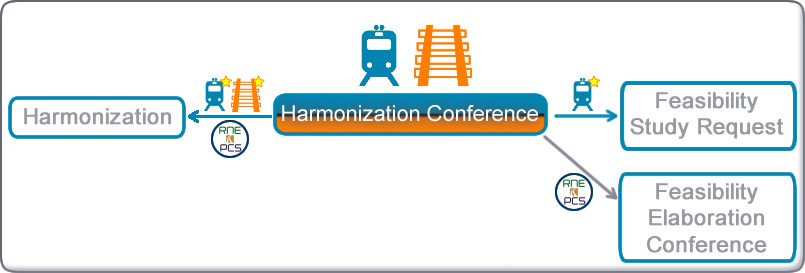
Transition list
- Harmonization Conference -> Feasibility Study Request
- Who: Leading Applicant
- Restrictions:
- All Applicant lights in green or yellow
- Mandatory common train parameters are fulfilled
- Harmonization Conference -> Harmonization
- Who:
- Leading Applicant
- Restrictions: None
- Leading IM
- Restrictions: None
- PCS system (Automatic promotion)
- Restrictions
- At least one Applicant light is in red or blue
- Applied the day after the dossier got into the Harmonization Conference phase
- Restrictions
- Leading Applicant
- Who:
- Harmonization Conference -> Feasibility Elaboration Conference
- Who: PCS system (Automatic promotion)
- Restrictions:
- All Applicant lights in green or yellow
- Mandatory common train parameters are fulfilled
- Only promoted if the dossier remains in Harmonization Conference after the second part of January (Please check PCS Calendar for the exact dates)
PERMISSIONS
- Leading Applicant
- Read and write access to its own section
- Applicants
- Read and write access to their own sections
- Leading IM
- Read and write access to its own section
- IMs
- Read and write access to their own sections
OTHER DETAILS
- In this phase, all the data is shared.
- If the dossier should run through the feasibility study, all the required data should be consulted, recorded and harmonized.
- If any Applicant disagrees its light should be on red to avoid the feasibility study request.
- Automatic back-to-harmonization for no activity
- The deadline of 8/15 days of no activity causing an automatic transfer from Harmonization Conference to Harmonization is switched off for about a week in January (Please search for “PCS process guidelines (year)” for the exact details)
- IMs can add/replace subpaths from the Applicant timetable to the IM timetable
- Applicants can add/replace subpaths from the IM timetable to the Applicant timetable
2.2 Phase Feasibility Study Request (FS Request)

DESCRIPTION
- It is a formal milestone for New Path Request and Ad Hoc Path Request processes
- Automatically goes into Feasibility Study Elaboration
- Before Mid-January the dossier is switched directly into the Feasibility Study Elaboration Conference state.
- Normal phase for Late Path Request process
- Dossier content is visible for all entered agencies
POSSIBLE TRANSITIONS

Transitions list
Only for Late Path Request. Automatic transition to Feasibility Study Elaboration in New and Ad Hoc Path Requests
- Feasibility Study Request -> Feasibility Study Elaboration
- Who: Leading IM
- Restrictions: None
- Feasibility Study Request -> Harmonization
- Who:
- Leading Applicant
- Restrictions: None
- Leading IM
- Restrictions: None
- Leading Applicant
- Who:
PERMISSIONS
Since this is a milestone in the New Path Request and Ad Hoc Path Request processes, the permissions, in a practical sense for the user, only apply to Late Path Request process.
- Leading Applicant
- Read-only
- Applicants
- Read-only
- Leading IM
- Read and write access to its own section
- IMs
- Read and write access to their own sections
OTHER DETAILS
- IM can replace IM Timetables with Applicant Timetables
- In Late Path Request, due to the short period of time to react, the Leading IM and the Leading Applicant have the possibility to withdraw the request back to harmonization.
2.3 Phase Feasibility Study Elaboration (FS E)

DESCRIPTION
- In this phase, the IMs prepare the timetable for the path study results or for the Conference with the Applicants.
- The Leading IM can copy the Applicant TT (See details below)
- After review, the Leading IM may consider going to Conference with the Applicants or send the Feasibility Study Result to the Applicants.
POSSIBLE TRANSITIONS
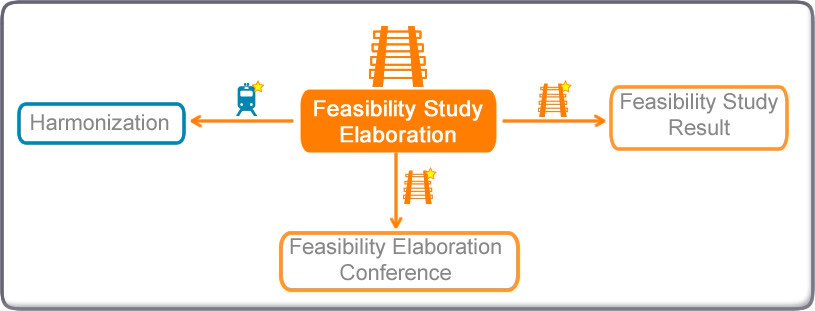
Transition list
- Feasibility Study Elaboration -> Harmonization
- Who: Leading Applicant
- Restrictions: None
- Feasibility Study Elaboration -> Feasibility Study Result
- Who: Leading IM
- Restrictions: None
- Feasibility Study Elaboration -> Feasibility Elaboration Conference
- Who: Leading IM
- Restrictions: None
PERMISSIONS
- Leading Applicant
- Withdraw dossier
- Read-only access
- Applicants
- Read-only access
- Leading IM
- Write access
- IMs
- Write access
- C-OSS
- Read-only access
OTHER DETAILS
- Each involved IM should prepare the corresponding section of the requested timetable. The elaborated path section should be in line with the neighbouring one.
- All common mandatory fields and IM-specific fields related to the particular operation points or the whole dossier must be filled.
- IMs can add/replace subpaths from the Applicant timetable to the IM timetable
2.4 Phase Feasibility Elaboration Conference (FS EC)

DESCRIPTION
The Feasibility Elaboration Conference phase is designed to allow Applicants and IMs to analyze and work in their respective timetables before sending the dossier back to the Feasibility Study Elaboration.
POSSIBLE TRANSITIONS

Transition list
- Feasibility Elaboration Conference -> Feasibility Study Elaboration
- Who: Leading IM
- Restrictions: None
- Who: Leading IM
- Feasibility Elaboration Conference -> Harmonization
- Who: PCS system (Automatic promotion)
- Restrictions: None
- Who: PCS system (Automatic promotion)
Permissions
- Leading Applicant
- Write access
- Applicants
- Write access
- Leading IM
- Write access
- IMs
- Write access
- C-OSS
- Read-only access
OTHER DETAILS
- If the leading IM wants to replace its TT with the Applicant one, he must return to the Feasibility Study Elaboration.
- The automatic transition by PCS back to Harmonization occurs if the dossier has not been visited in 8 days or has not changed in the last 15 days.
- IMs can add/replace subpaths from the Applicant timetable to the IM timetable
- Applicants can add/replace subpaths from the IM timetable to the Applicant timetable
2.5 Phase Feasibility Study Result (FS Result)

DESCRIPTION
- This is the last phase of the Feasibility Study Process. The content of the dossier is visible to all the involved participants
- The leading Applicant acknowledges the offered harmonized path sections from the IMs to continue with the Harmonization phase.
POSSIBLE TRANSITIONS

Transition list
- Feasibility Study Result -> Harmonization
- Leading Applicant
- Restrictions: None
- Feasibility Study Result -> Feasibility Study Elaboration
- Who: Leading IM
- Restrictions: None
- Who: Leading IM
PERMISSIONS
- Leading Applicant
- Read-only access
- Applicants
- Read-only access
- Leading IM
- Read-only access
- IMs
- Read-only access
- C-OSS
- Read-only access
OTHER DETAILS
- Leading IM has the right to withdraw the Feasibility study response if necessary.
- Exiting the process the feasibility timetable is created and saved
3. Phase Path Request (PR)
Without RFC

With RFC

Description
- The Path Request phase is a formal milestone for all process types.
Possible transitions
- Path Request -> Path Elaboration
- PCS system (Automatic promotion)
- Restrictions: None
- PCS system (Automatic promotion)
- Path Request -> Pre-booking
- PCS system (Automatic promotion)
- Restrictions: None
- PCS system (Automatic promotion)
Permissions
No user interaction. The dossier is immediately forwarded to the next phase.
4. Phase Pre-booking (PB)

DESCRIPTION
- When an Applicant requests at least one Pre-arranged path (PaP)s in the dossier, it first enters the pre-booking phase after releasing it from the harmonization phase
- In this phase, the C-OSS managers will pre-book the Pre-arranged paths (PaPs) or will pre-book the accepted alternative PaPs
- Once the dossier arrives at pre-booking, the system generates a dedicated area for the C-OSS managers by copying the Applicant timetable to a C-OSS Timetable
- Coordinating C-OSS managers (those who published the PaPs) have editing rights on their own timetable PaP section
POSSIBLE TRANSITIONS
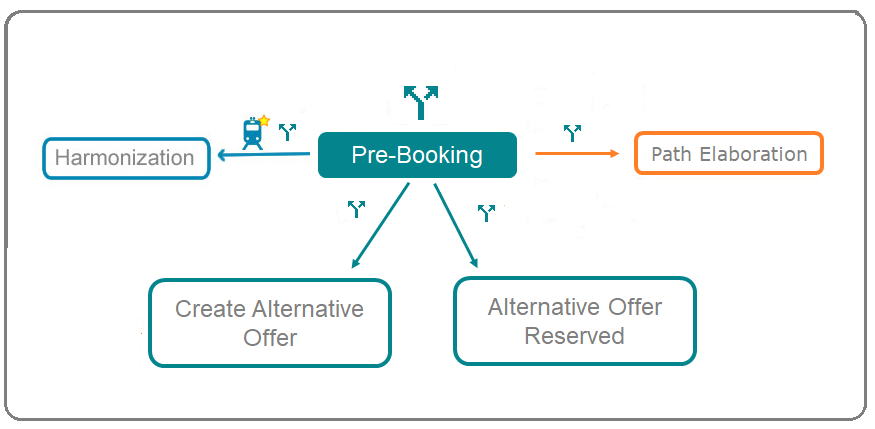
Transition list
- Pre-booking -> Harmonization
- Who: Leading Applicant (withdraw), C-OSS Manager (reject)
- Restrictions: None
- Pre-booking -> Path Elaboration
- Who: C-OSS manager
- Restrictions
- All involved C-OSS lights must be in green
- Complete all missing data
- Pre-booking-> Create Alternative Offer
- Who:
- C-OSS manager
- Restrictions
- All involved C-OSS must process all PaPs
- Restrictions
- C-OSS manager
- Who:
PERMISSIONS
- C-OSS manager
- Reject dossier
- Create Alternate Offer
- Release Path Elaboration
- Write access on their own section
- Leading Applicants
- Withdraw Dossier
- Read Everything
- Applicants
- Read Everything
- Leading IM
- Read Everything
- IMs
- Read Everything
OTHER DETAILS
- The Pre-booking phase is not supported for partially harmonized dossiers
- The system shall maintain the requested and reserved capacity based on the C-OSS timetable for dossiers in the Pre-booking phase
- If the PaP Details window the PaPs marked with Alternative Offer Accepted or Alternative Offer Rejected color-coding it means that the dossier was in the Alternative Offer phases before
4.1 Phase Alternative Offer Created (AOC)

DESCRIPTION
- One of the ways to start the alternative offer process where C-OSS managers to check the PaP requests and fix minor issues.
- The Create Alternative Offer phase can start only if all involved C-OSS manager has accepted the PaPs by marking the PaP origin-destination pair into a green, reserved state.
- Editing possibilities on the PaP path sections and intermediate path sections on their corridor are the following:
- Arrival and departure times (actual/earliest/latest)
- Dwell time
- Catalog path number
- Train number
- Common train parameters
- Path section level parameters
- Conditions:
- The same rule applied as for IMs editing times of PaP path sections (e.g. regular Flex PaP point)
- C-OSS can add an intermediate PaP path section or remove the existing that was created by the Applicant
POSSIBLE TRANSITIONS

Transition list
- Create Alternative Offer -> Pre-booking
- Who: C-OSS manager
- Restrictions: None
- Who: C-OSS manager
- Create Alternative Offer -> Alternative offered
- Who:
- C-OSS manager
- Restrictions: None
- Mandatory fields and IM parameters are fulfilled
- C-OSS manager
- Who:
PERMISSIONS
- C-OSS manager
- Read and write access to its own section
- Leading Applicant
- Read anything
- Applicants
- Read anything
- Leading IM
- Read anything
- IMs
- Read anything
OTHER DETAILS
- The dossier should run through the alternative offer branch phases, and all the required data should be harmonized.
- If any C-OSS manager disagrees its light should be on red to avoid creating an alternative offer
4.2 Phase Alternative Offer Reserved (AO Reserved)

DESCRIPTION
- One of the ways to start the alternative offer process where C-OSS managers is to check the PaP requests and fix minor issues.
- To start the process in the PaP details menu, the C-OSS manager has to select the PaP origin-destination pair/s to be replaced and look for alternatives by pressing the “Search alternatives” button.
- It opens the PaP search window, and the available published PaPs are displayed in the table as a result of the search according to the desired criteria.
- Once the alternative PaP has been selected the C-OSS timetable will be editable and ready to develop the request according to their business needs
- Editing possibilities on the PaP path sections and intermediate path sections on their corridor are the following:
- Arrival and departure times (actual/earliest/latest)
- Dwell time
- Catalog path number
- Train number
- Common train parameters
- Path section level parameters
- If the C-OSS manager is happy with the new alternative PaP then Reserve the Alternative Offer
POSSIBLE TRANSITIONS

Transition list
- Alternative Offer Reserved -> Pre-booking
- Who: C-OSS manager
- Restrictions: None
- Who: C-OSS manager
- Alternative Offer Reserved -> Alternative offered
- Who:
- C-OSS manager
- Restrictions: None
- Mandatory fields and IM parameters are fulfilled
- C-OSS manager
- Who:
PERMISSIONS
- C-OSS manager
- Read and write access to its own section
- Leading Applicant
- Read anything
- Applicants
- Read anything
- Leading IM
- Read anything
- IMs
- Read anything
OTHER DETAILS
- Offering an alternative PaP request is only possible from this phase.
- Once the Alternative offer is reserved it copies the PaP request into the C-OSS timetable and the C-OSS timetable becomes disabled.
- The last action of this phase is to submit the alternative offer to inform the Applicant about changes.
4.3 Phase Alternative Offered (AO)

DESCRIPTION
- In this phase, the prepared alternative offer is sent for the Applicants’ review
- The C-OSS timetable is available with reading rights to check the offer
- Applicants have writing rights in Control where they send their decision by setting the lights.
POSSIBLE TRANSITIONS

Transition list
- Alternative Offered -> Pre-booking
- Who: C-OSS manager
- Restrictions: None
- Who: C-OSS manager
- Alternative Offered -> Alternative Offer Accepted
- Who:
- Leading Applicant
- Restrictions: All Applicants have to accept the dossier by setting their lights to green
- Leading Applicant
- Who:
- Alternative Offered -> Alternative Offer Rejected
- Who:
- Leading Applicant
- Restrictions: None
- Leading Applicant
- Who:
PERMISSIONS
- C-OSS manager
- Withdraw Alternative Offer
- Read anything
- Leading Applicant
- Accept or Reject Alternative Offer
- Read anything
- Applicants
- Accept or reject Alternative Offer
- Read anything
- Leading IM
- Read anything
- IMs
- Read anything
OTHER DETAILS
- If the lights for the involved Applicants are green then the “Accept Alternative offer” button will be enabled, and the leading agency will send their acceptance by pressing the button.
- At least one Applicant who rejects the offer and sets the light to red colour, must enter the reason for rejection and the “Reject Alternative Offer” button will be enabled.
4.4 Phase Alternative Offer Accepted (AOA)

DESCRIPTION
- The Alternate Offered accepted by the Applicants their lights are green in the dossier
- Once the Applicants submit their acceptance the C-OSS timetable is not visible to the Applicants only the Applicants’ timetable
- Applicants and IMs have reading rights in the whole dossier
POSSIBLE TRANSITIONS

Transition list
- Alternative Offer Accepted -> Pre-booking
- Who: C-OSS manager
- Restrictions: None
- Who: C-OSS manager
PERMISSIONS
- C-OSS manager
- Proceed to Pre-booking
- Read anything
- Leading Applicant
- Read anything
- Applicants
- Read anything
- Leading IM
- Read anything
- IMs
- Read anything
OTHER DETAILS
- Once the offer is accepted by the Applicants the C-OSS timetable is updated with the new alternative offer
- In the C-OSS PaP details window, the accepted request turns into green colour-coding, indicating the acceptance of the request
- C-OSS managers have to proceed back to Prebooking to continue the promotion of the dossier to Path Elaboration
4.5 Phase Alternative Offer Rejected (AO Rejected)

DESCRIPTION
- The Alternate Offered rejected by at least one of the Applicant setting their light to red colour in the dossier
- Once the Applicants submit their rejection the C-OSS timetable is not visible to the Applicants only the Applicants’ timetable
- Applicants and IMs have reading rights in the whole dossier
POSSIBLE TRANSITIONS

Transition list
- Alternative Offer Rejected -> Pre-booking
- Who: C-OSS manager
- Restrictions: None
- Who: C-OSS manager
PERMISSIONS
- C-OSS manager
- Proceed to Pre-booking
- Read anything
- Leading Applicant
- Read anything
- Applicants
- Read anything
- Leading IM
- Read anything
- IMs
- Read anything
OTHER DETAILS
- Once the offer is rejected by the Applicants the C-OSS timetable is NOT updated with the new alternative offer
- In the C-OSS PaP details window, the rejected request turns into orange color-coding, indicating the rejection of the request
- C-OSS managers have to proceed back to Prebooking to reoffer an alternative offer
5. Phase Path Elaboration (PE)
WITHOUT RFC

WITH RFC

- IMs review the path request and prepare the draft offer. Once the draft offer is complete, they can submit it to the observation phase
- The offer should be harmonized with the neighbours
- If the Draft Offer deadline has passed and one of the IMs is late in preparing the offer, the IMs who finished on time can make a partial offer and start the partial harmonization process to move on to reach the Final Offer phase; only if the dossier does not contain PaPs.
- If the dossier contains PaPs then the involved RFC gets the leading role until the Active timetable phase. With this role, RFCs can check the offer after IMs finalize the preparation of their draft offer. The partial harmonization process is not supported for dossiers with PaPs.
- Once the dossier reached the path elaboration phase the following timetable will be copied over to the IM timetable:
- New path request without PaPs: Applicant timetable
- New path request with PaPs: C-OSS timetable
- For the Late Path request and Adhoc process types, the leading IM is in charge of changing the phase and manually promoting the dossier otherwise PCS will not send the offer to the Applicants.
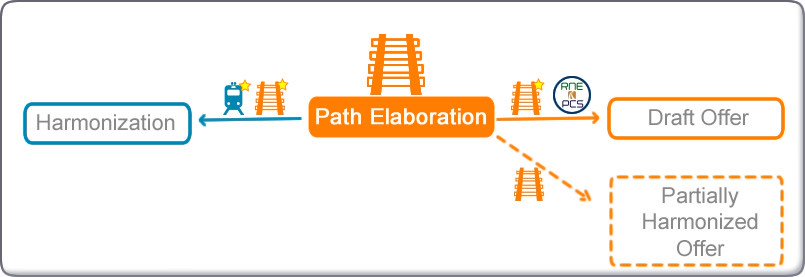
New Path request with PaPs

- Path Elaboration -> Draft Offer
- Who:
- Leading IM
- Restrictions
- IM own reference point: Mandatory times completed
- IM lights all green
- Restrictions
- PCS system (Automatic promotion)
- Restrictions
- IM own reference point: Mandatory times completed
- IM lights all green
- Restrictions
- Leading IM
- Who:
- Path Elaboration -> Partially Harmonized Offer
- Who:
- Any IM
- Restrictions
- IM own reference point: Mandatory times completed
- IM own light green
- Restrictions
- Any IM
- Who:
- Path Elaboration -> Harmonization
- Who:
- Leading Applicant: Withdraw dossier (IM TT, if it exists, is deleted in the process)
- Leading IM: Reject Dossier
- Restrictions: None
- Who:
NEW PATH REQUEST WITH PAPS
- Path Elaboration -> Draft Offer
- Who:
- C-OSS
- Restrictions
- IM own reference point: Mandatory times completed
- IM lights all green
- Restrictions
- PCS system (Automatic promotion)
- Restrictions
- IM own reference point: Mandatory times completed
- IM and C-OSS lights are all green
- Restrictions
- C-OSS
- Who:
- Path Elaboration -> Harmonization
- Who:
- Leading Applicant: Withdraw dossier (IM TT, if it exists, is deleted in the process)
- C-OSS: Reject Dossier
- Restrictions: None
- Who:
- Leading Applicant
- Read-only access to the submitted Applicant Timetable
- Edit train composition only
- Withdraw dossier back to Harmonization
- Read-only access to the IM TT after the Draft offer deadline
- Applicants
- Read-only access to the submitted Applicant Timetable
- Read-only access to the IM TT after the Draft offer deadline
- Edit train composition only
- Leading IM
- Read access to the whole dossier
- Write access to its own section (own IM TT)
- Reject dossier
- IMs
- Read-only access to the whole dossier
- Write access to its own section (own IM TT)
- C-OSS
- Read-only access to the whole dossier timetable area
- The leading role only to promote the dossier
OTHER DETAILS
Read-only access to Applicants after the Draft Offer Deadline
To give applicants transparent information in the path elaboration phase, all involved Applicants will have read-only access to the IM-timetable after the draft offer deadline for delayed dossiers.
The read-only access description:
- IM’sacceptance indicator is green, the IM timetable will be visible
- IM’s acceptance indicator is NOT green, the IM timetable will NOT be visible to Applicants. A warning message indicates that ” The offer is still in progress”
- In the Path Elaboration and in the Post-processing phases PCS displays the status of the acceptance indicators in “Control” or in “Basic Data” (in the participating companies section) to identify who is green, red, yellow, or blue.
If the Applicant needs to withdraw the path request, the Process type very much depends on when the action is done. The Path Request Deadline is the reference date & time of this action.
a. Before the path request deadline
If the Applicant withdraws the path request and submits it again before the Path Request Deadline, it will have no impact on the process type of the dossier it stays unchanged.
All Applicants should check the dossier to make sure that the requirements for the Path Request Deadline are completed:
- Missing mandatory parameters are fulfilled
- Calendar synchronized
- All Applicants must have green lights
b. After the path request deadline
If an Applicant already submitted the path request and the withdrawal is done after the Path Request Deadline for the New Path Request, the dossier process type will change to Late Path Request!
Partially Harmonized Offer details
For a detailed description of the Partial Harmonization process, please visit our document.
6. Phase Draft Timetable (DO)

DESCRIPTION
- Draft Offer is a formal milestone. Its object is to store the state of a finished path
- For the Late and Ad-hoc Request are renamed as “Late Request Offer” and “Ad hoc Request Offer” (See an example of the first one below)

POSSIBLE TRANSITIONS
Transition list
- Draft Offer -> Observations
- PCS system (Automatic promotion)
- Restrictions: None
- PCS system (Automatic promotion)
PERMISSIONS
No user interaction. The dossier is immediately forwarded to the next phase Observations / Acceptance regarding the path request process.
7. Phase Observations

- The observations phase is part of the New Path Request process only (annual timetable)
- The “Acceptance” phase is the name for Late Path Requests and Ad Hoc Request Processes
- Leading Applicants in the Acceptance phase can switch the dossier directly into the Active Timetable phase (skip Post-processing and Final Offer phases)
- During this phase, the Applicants check the offer from the IMs. They can make their comments and ask for improvements or agree with the offer
POSSIBLE TRANSITIONS
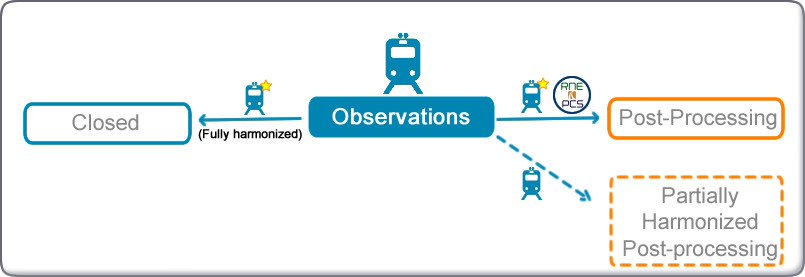
Late Path Request and Ad Hoc Path Request Processes

- Observations -> Post-processing
- Who:
- Leading Applicant
- Restrictions: None
- PCS system (Automatic promotion)
- Restrictions: after spending 30 days in the phase “observation”, for the dossiers without the triggered partial harmonization, regardless of the date when the dossier reached Observation (Check CR 1403 for reference)
- Leading Applicant
- Who:
- Observations -> Closed
- Who: Leading Applicant
- Restrictions: None
- Who: Leading Applicant
- Observations -> Partially Harmonized Post-processing
- Who: Any Applicant
- Restrictions: None
- Who: Any Applicant
- Acceptance -> Active Timetable
- Who: Leading Applicant
- Restrictions: None
- Who: Leading Applicant
- Acceptance -> Post-processing
- Who:
- Leading Applicant
- Restrictions: None
- PCS system (Automatic promotion)
- Restrictions: only until the deadline
- Leading Applicant
- Who:
- Acceptance -> Closed
- Who:
- Leading Applicant
- Restrictions: None
- Who:
- Acceptance -> Partially Harmonized Post-processing
- Who: Any Applicant
- Restrictions: None
- Who: Any Applicant
- Leading Applicant
- Read-only access to the rest of the dossier except Train Composition
- Make comments
- Close dossier, promote dossier
- Applicants
- Read-only access to the rest of the dossier except Train Composition
- Make comments
- Leading IM
- Read-only access to the whole dossier
- IMs
- Read-only access to the whole dossier
- Dossiers in the partial offer process are promoted to Post-processing by each Applicant in pairs independently.
- Use of comments
- Applicants can make their comments in the free text field but it is recommended to use the observation feature “Make comment” to have the comment clear and structured
- Predefined “Make comment” fields
- What is touched: involved IMs, involved parts of the dossier
- Observation type
- like Route not correct, lack of date, timetable not harmonized
- Justified objection
- Reminder for dossier acceptance: PCS sends a notification email to all involved applicants in the Final Offer and Acceptance phases if their light is still blue or yellow 3 days after the offer. With that, the Applicant will be warned within the 5-day acceptance period. The notification services work in the following process types:
- New Path Request, TTR New Path Request: Final Offer
- Rolling Planning: Final Offer
- Ad-hoc: Acceptance
- Late Path Request: Acceptance, Final Offer
8. Phase Post-processing (PP)

DESCRIPTION
- The IMs review the applicants’ observations and comments and take them into consideration to finalize the offer.
- For the partial harmonization offers, PCS checks on a daily basis the colours of the IMs’ lights, and if all IMs light green merge the separate streams into one. The partially harmonized offer becomes harmonized again.
POSSIBLE TRANSITIONS
New Path request without PaPs

New Path request with PaPs

Transition list: New Path request without PaP
- Post-processing -> Final Offer
- Who:
- Leading IM
- Restrictions
- IM own reference point: Mandatory times completed
- Must fill all common mandatory and IM-specific parameters
- IMs lights are all green
- Restrictions
- PCS system (Automatic promotion)
- Restrictions
- IM own reference point: Mandatory times completed
- Must fill all common mandatory and IM-specific parameters
- IMs lights are all green
- Restrictions
- Leading IM
- Who:
- Post-processing -> Partially Harmonized Offer
- Who:
- Any IM
- Restrictions
- IM own reference point: Mandatory times completed
- Must fill all common mandatory and IM-specific parameters
- IM section light on green
- Restrictions
- PCS system (Automatic promotion)
- Restrictions
- IM own reference point: Mandatory times completed
- Must fill all common mandatory and IM-specific parameters
- IM section light on green
- Restrictions
- Any IM
- Who:
- Post-processing -> Closed
- Who:
- Leading IM: Close Dossier
- Restrictions: Only possible with the dossier fully harmonized. Not possible with a partial offer state.
- Who:
Transition list: New Path Request with PaPs
- Post-processing -> Final Offer
- Who:
- C-OSS
- Restrictions
- IM own reference point: Mandatory times completed
- Must fill all common mandatory and IM-specific parameters
- IMs lights are all green
- Restrictions
- PCS system (Automatic promotion)
- Restrictions
- IM own reference point: Mandatory times completed
- Must fill all common mandatory and IM-specific parameters
- C-OSS/IMs lights all green
- Restrictions
- C-OSS
- Who:
- Post-processing -> Closed
- Who:
- C-OSS: Close Dossier
- Restrictions: Only possible with the dossier fully harmonized. Not possible with a partial offer state.
- Who:
PERMISSIONS
- Leading Applicant
- Read-only dossier
- Train composition is editable at any time
- Applicants
- Read-only dossier
- Train composition is editable at any time
- Leading IM
- Write access to its own section. Read-only access to the rest of the dossier
- Promote dossier
- IMs
- Write access to its own section. Read-only access to the rest of the dossier
- C-OSS
- Read-only access to the whole dossier timetable area, write access in Control to set acceptance indicators
- The leading role only to promote the dossier
OTHER DETAILS
Read-only access to Applicants after the Draft Offer Deadline
To give applicants transparent information in the path elaboration phase. PCS ensures after the draft offer deadline the read-only access to the IM-timetable for delayed dossiers.
The read-only access description
- IMs with green acceptance indicators, the IM timetable will be visible
- IMs acceptance indicators are NOT green, the IM timetable will NOT be visible. A warning message indicates that ” The offer is still in progress”
- In the Path Elaboration and in the Post-processing phases PCS displays the status of the acceptance indicators in “Control” or in “Basic Data” (at the participating companies section) to identify who is green, yellow, or blue.
Partially Harmonized Offer details
For a detailed description of the Partial Harmonization process, please visit our document.
9. Phase Final Offer (FO)

DESCRIPTION
- Applicants decide if they accept and obtain the offered final timetable version.
- All Applicants must change their lights to green in order to achieve Active Timetable
POSSIBLE TRANSITIONS

Transition list
- Final Offer -> Active Timetable
- Who:
- Leading Applicant
- Restrictions: All Applicant lights have been changed to green
- PCS system (Automatic promotion)
- Restrictions: All Applicant lights have been changed to green
- Leading Applicant
- Who:
- Final Offer -> Closed
- Who: Leading Applicant
- Restrictions: None
PERMISSIONS
- Leading Applicant
- Read-only access
- Close dossier, promote the dossier
- Applicants
- Read-only access
- Change your own light to green
- Leading IM
- Read-only access
- IMs
- Read-only access
OTHER DETAILS
- Automatic promotion
- The system checks in a certain period of time after the deadline every night at 23:00 if there are any dossiers with all Applicants’ lights on green.
- Dossiers in Partial offer may only be switched harmonized to the Active timetable.
- This is to prevent a dossier with one part still in some previous phase, while other parts are already in the Active timetable, allowing starting of the path modification process.
- Once the Applicants have set their acceptance indicators to green in a dossier in Partial offer mode and in the Final offer phase, it is not possible to change them again to Yellow or Red.
- Reminder for dossier acceptance: PCS sends a notification email to all involved applicants in the Final Offer and Acceptance phases if their light is still blue or yellow 3 days after the offer. With that, the Applicant will be warned within the 5-day acceptance period. The notification services work in the following process types:
- New Path Request, TTR New Path Request: Final Offer
- Rolling Planning: Final Offer
- Ad-hoc: Acceptance
- Late Path Request: Acceptance, Final Offer
10. Phase Active Timetable (AT)

DESCRIPTION
- This is the final phase of the path request.
- The dossier contains the agreed valid state of the path for a particular timetable period.
POSSIBLE TRANSITIONS

Transition list
- Active Timetable -> Path Modification
- Who: Any Applicant
- Restrictions: None
- Active Timetable -> Path Alteration
- Who: Any IM
- Restrictions: None
- Active Timetable -> Closed
- Who:
- Leading Applicant or Leading IM
- Restrictions: Only possible after the timetable period starts
- PCS system (Automatic promotion)
- Restrictions: After two calendar years after the timetable year of the dossier
- The dossier is in Active Timetable
- Leading Applicant or Leading IM
- Who:
PERMISSIONS
- Read-only access for all participants
OTHER DETAILS
- Each Applicant (IM) can start the path modification (alteration) process by submitting a path modification (alteration) conference if some modification (adjustment) is needed.
- When the timetable period of the path expires, the dossier should be deactivated into the phase Closed by the leading Applicant or leading IM.
10.1.1 Phase Path Modification Conference (PM C)

DESCRIPTION
- This is the first phase of the path modification process.
- Originator Applicant starts creating the modification request on the current existing agreed dossier by submitting a path modification conference from the Active timetable phase.
- From Active Timetable, any Applicants involved in the dossier can enter this phase as Originator.
POSSIBLE TRANSITIONS

Transition list
- Path Modification Conference -> Path Modification Request
- Who:
- Originator Applicant
- Restrictions: All involved Applicants lights must be green
- Originator Applicant
- Who:
- Path Modification Conference -> Active Timetable
- Who:
- Leading Applicant
- Restrictions: None
- Leading Applicant
- Who:
Permissions
- C-OSS
- Read-only access
- Leading Applicant
- Withdraw Path Modification
- Switch to Adjustment
- Submit Path Modification request
- Write access
- Applicants
- Write access
- Leading IM
- Read-only access
- IMs
- Read-only access
OTHER DETAILS
- The modification requirements should be defined by all Applicants who are affected by the modification.
- Path cancellation has been prevented in PCS, users are not able to cancel days that were already allocated. The Path cancellation type of reason has been removed from the path modification conference phase in version 2.64.0 release changes (RNE014-5427). If Applicants need to request path cancellation, then it should be done outside of PCS.
10.1.2 Phase Path Modification Request (PM Request)
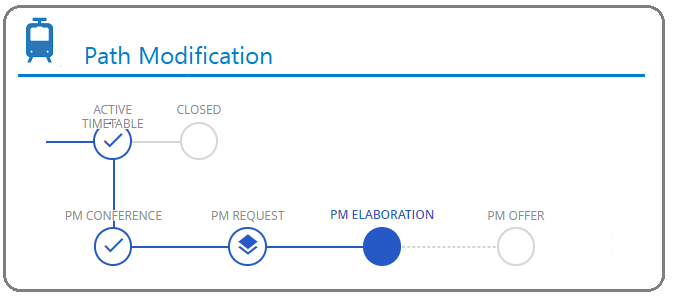
DESCRIPTION
This phase is treated as a milestone.
POSSIBLE TRANSITIONS

Transition list
- Path Modification Request -> Path Modification Elaboration
- Who:
- PCS system (Automatic promotion)
- Restrictions: None
- PCS system (Automatic promotion)
- Who:
Permissions
- C-OSS
- Read-only access
- Leading Applicant
- Read-only access
- Applicants
- Read-only access
- Leading IM
- Read-only access
- IMs
- Read-only access
OTHER DETAILS
No action is needed. The dossier is immediately moving to the next phase, to the Path Modification Elaboration phase.
10.1.3 Phase Path Modification Elaboration (PM E)

DESCRIPTION
IMs prepare the modified path.
POSSIBLE TRANSITIONS

Transition list
- Path Modification Elaboration -> Path Modification Offer
- Who:
- Leading IM
- Restrictions: All lights must be green
- Leading IM
- Who:
- Path Modification Elaboration -> Active Timetable
- Who:
- Leading IM
- Restrictions: None
- Leading Applicant
- Restrictions: None
- Leading IM
- Who:
Permissions
- C-OSS
- Read-only access
- Leading Applicant
- Read-only access
- Applicants
- Read-only access
- Leading IM
- Reject Path Modification Request
- Submit Path Modification Offer
- Write access in its own section
- IMs
- Write access in its own section
OTHER DETAILS
- When IM finishes his work on the dossier, his/her path-related light should be set to green.
- When all path-related lights are on green, IM in pair with the originator Applicant submits the path modification offer.
- If modification is not feasible, IM in pair with the initiator Applicant has the right to reject the path modification. Then dossier returns to the Active timetable phase.
- Originator Applicant can withdraw the path modification at any time then the dossier returns to the Active timetable phase.
10.1.4 Phase Path Modification Offer (PM O)

DESCRIPTION
Applicants decide if they accept the modified timetable or return to the state before the start of the path modification process.
POSSIBLE TRANSITIONS
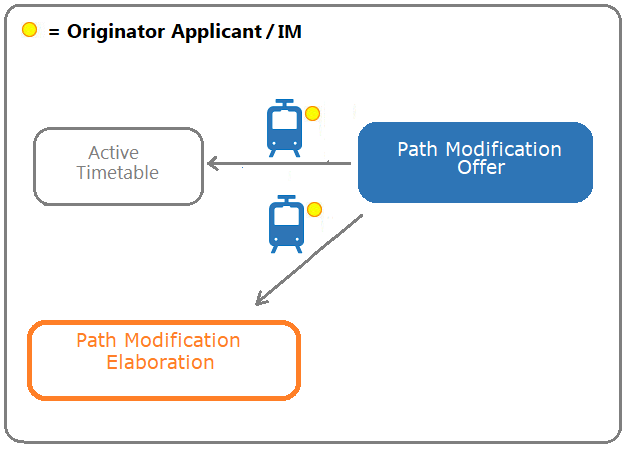
Transition list
- Path Modification Offer -> Active Timetable
- Who:
- Leading Applicant
- Restrictions: None
- Leading Applicant
- Who:
- Path Modification Offer -> Path Modification Elaboration
- Who:
- Leading Applicant
- Restrictions: None
- Leading Applicant
- Who:
Permissions
- C-OSS
- Read-only access
- Leading Applicant
- Write access in its own section
- Ask for offer adoption
- Accept path modification offer
- Reject path modification offer
- Applicants
- Write access in its own section
- Leading IM
- Read-only access
- IMs
- Read-only access
OTHER DETAILS
- The involved Applicant agrees, disagrees or asks for adaption.
- When some of the affected Applicants ask for offer adaptation, the dossier returns one step back to the Path Modification Elaboration phase. When the Applicant agrees, his/her path-related light should be set up on the green.
- When all path-related lights are on green, the originator Applicant has to accept the path modification offer. The dossier returns back to the Active timetable phase with the new valid state.
- When some affected Applicant disagrees with the offer, he has to reject the path modification offer. Then dossier returns to the Active timetable phase into the originally agreed state.
10.2.1 Phase Path Alteration Conference (PA C)

DESCRIPTION
- This is the first phase of the path alteration process. Allows the IMs the possibility to ask for alteration for one part or for the whole validity period of the dossier
- Originator IM starts the creation of alteration on the current existing agreed dossier by submitting a path alteration conference from the Active timetable phase.
- From Active Timetable, any IM involved in the dossier can enter this phase as an Originator.
POSSIBLE TRANSITIONS
Transition list
- Path Alteration Conference -> Path Alteration Offer
- Who:
- Originator IM
- Restrictions: All involved IMs lights must be green
- Originator IM
- Who:
- Path Alteration Conference -> Active Timetable
- Who:
- Leading IM
- Restrictions: None
- Leading IM
- Who:
Permissions
- C-OSS
- Read-only access
- Leading Applicant
- Read-only access
- Applicants
- Read-only access
- Originator IM
- Write access
- IMs
- Write access
OTHER DETAILS
- Such alteration can be proposed for one part or for the whole validity period.
- The necessary alteration should be provided by all IM affected in the alteration.
- The system will help with this part with the path alteration conference wizard.
- Necessity:
- There should be a classified reason for the path alteration conference in the wizard.
- It is important to define whether the other IMs are affected by the alteration or not.
10.2.2 Phase Path Alteration Offer (PA Offer)
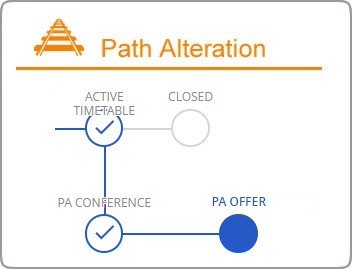
- This is the second and last phase for the path alteration process.
- Applicants decide if they
- Accept the altered timetable
- Return to Path Alteration Conference for further adaptation
- Return to the Active Timetable without any changes.
POSSIBLE TRANSITIONS

Transition list
- Path Alteration Offer -> Active Timetable (Changes accepted)
- Who: Affected Applicant
- Restrictions: None
- Who: Affected Applicant
- Path Alteration Offer -> Active Timetable (No changes)
- Who: Affected Applicant
- Restrictions: None
- Who: Affected Applicant
- Path Alteration Offer -> Path Alteration Conference
- Who:
- Affected Applicant
- Restrictions: None
- Originator IM
- Restrictions: None
- Affected Applicant
- Who:
Permissions
- C-OSS
- Read-only access
- Leading Applicant
- Read-only access
- RUs
- Read-only access
- Originator IM
- Read-only access
- IMs
- Read-only access
OTHER DETAILS
- The Affected applicant has to agree, disagree or could ask for adaptation.
- When some of the affected applicants ask for offer adaptation, the dossier returns one step back to the Path Alteration Conference phase.
- When an applicant agrees, his path-related light should be set up on the green. When all path-related lights are on green, an applicant in pair with the originator IM has to accept the path alteration offer.
- The dossier is moved to the phase Active timetable with the new valid state.
- When some affected applicant disagrees with the offer, he has to reject the path alteration offer. Then dossier returns to the Active timetable phase into the originally agreed state.
11. Phase Closed

DESCRIPTION
- This is the last phase for all dossiers that are not needed anymore or the timetable period expires.
- No other action is possible other than copying the dossier.
POSSIBLE TRANSITIONS
- None
PERMISSIONS
- Read-only access for everybody
12.1 Phase Open (PaP)

This is the first phase of the pre-arranged path process. C-OSS starts the creation of completely new PaPs in the PaP manager wizard. If C-OSS creates PaP via import, this phase is treated as a milestone, and the dossier is immediately promoted to the next phase Path Elaboration (PaP).
Rights: Read and write access has only the C-OSS, who creates. Involved IMs have only read access.
Object: Basic data should be recorded. There should be defined types of PaP, locations, and parameters.
Control: When C-OSS saves the PaP as a draft in the PaP manager, the dossier is automatically promoted to the Path Elaboration (PaP) phase.
12.2 Phase Path Elaboration (PaP)

This is the second phase of the pre-arranged path process if the C-OSS manually creates the PaP in the PaP manager. If the C-OSS uses the Excel importer, the PaP dossier is immediately promoted to the Path Elaboration (PaP) phase skipping the Open (PaP) phase.
Rights: C-OSS managers and IMs have write access
Object: Once the edited PaP is finalized the C-OSS manager sets the green light on behalf of the IM
Control: If the construction of the PaP is completed, it should be published otherwise it stays in the draft version and applicants cannot request the PaP offer.
12.3 Phase Published (PaP)

This is the third phase of the pre-arranged path process. The dossier contains published PaP.
Rights: Everybody has read-only access.
Object: published PaP is available for pre-constructed product search
Control: If it requires some changes, C-OSS withdraws the PaP dossier back to the path elaboration (PaP) phase, modifies it, and republishes it again. Withdrawal is only possible if the PaP is not used in any active dossier.
When the PaP validity expires, it should not be published, C-OSS has to close the pre-arranged path.
12.4 Phase Closed (PaP)

This is the last phase for all pre-arranged paths. This phase is all about closing PaPs due to the fact that they are not required anymore or when the timetable is expired. There is no other possible action. The dossier serves copying purposes or it gives historical information.

